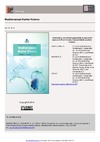Identificador persistente para citar o vincular este elemento:
https://accedacris.ulpgc.es/handle/10553/49575
| Campo DC | Valor | idioma |
|---|---|---|
| dc.contributor.author | García-Sanz, S. | en_US |
| dc.contributor.author | Navarro, P. G. | en_US |
| dc.contributor.author | Tuya, F. | en_US |
| dc.date.accessioned | 2018-11-24T09:03:05Z | - |
| dc.date.available | 2018-11-24T09:03:05Z | - |
| dc.date.issued | 2014 | en_US |
| dc.identifier.issn | 1108-393X | en_US |
| dc.identifier.uri | https://accedacris.ulpgc.es/handle/10553/49575 | - |
| dc.description.abstract | Despite sea-urchins can play an important role affecting the community structure of subtidal bottoms, factors controlling the dynamics of sea-urchin populations are still poorly understood. We assessed the seasonal variation in recruitment of three sea-urchin species (Diadema africanum, Paracentrotus lividus and Arbacia lixula) at Gran Canaria Island (eastern Atlantic) via monthly deployment of artificial collectors throughout an entire annual cycle on each of four adjacent habitat patches (seagrasses, sandy patches, ‘urchin-grazed’ barrens and macroalgal-dominated beds) within a shallow coastal landscape. Paracentrotus lividus and A. lixula had exclusively one main recruitment peak in late winter-spring. Diadema africanum recruitment was also seasonal, but recruits appeared in late summer-autumn, particularly on ‘urchin-grazed’ barrens with large abundances of adult conspecifics. In conclusion, this study has demonstrated non-overlapping seasonal recruitment patterns of the less abundant species (P. lividus and A. lixula) with the most conspicuous species (D. africanum) in the study area. | en_US |
| dc.language | eng | en_US |
| dc.publisher | 1108-393X | |
| dc.relation.ispartof | Mediterranean Marine Science | en_US |
| dc.source | Mediterranean Marine Science [ISSN 1108-393X], v. 15, p. 475-481 | en_US |
| dc.subject | 240119 Zoología marina | en_US |
| dc.subject.other | Recruitment | en_US |
| dc.subject.other | Artificial collectors | en_US |
| dc.subject.other | Coastal habitats | en_US |
| dc.subject.other | Canary Islands | en_US |
| dc.title | Contrasting recruitment seasonality of sea urchin species in Gran Canaria, Canary Islands (eastern Atlantic) | en_US |
| dc.type | info:eu-repo/semantics/Article | en_US |
| dc.type | Article | en_US |
| dc.identifier.doi | 10.12681/mms.547 | |
| dc.identifier.scopus | 84913540242 | - |
| dc.identifier.isi | 000345296200001 | |
| dc.contributor.authorscopusid | 55334747600 | - |
| dc.contributor.authorscopusid | 8639201700 | - |
| dc.contributor.authorscopusid | 6603608107 | - |
| dc.description.lastpage | 481 | - |
| dc.description.firstpage | 475 | - |
| dc.relation.volume | 15 | - |
| dc.investigacion | Ciencias | en_US |
| dc.type2 | Artículo | en_US |
| dc.contributor.daisngid | 4538917 | |
| dc.contributor.daisngid | 2276623 | |
| dc.contributor.daisngid | 308553 | |
| dc.utils.revision | Sí | en_US |
| dc.contributor.wosstandard | WOS:Garcia-Sanz, S | |
| dc.contributor.wosstandard | WOS:Navarro, PG | |
| dc.contributor.wosstandard | WOS:Tuya, F | |
| dc.date.coverdate | Enero 2014 | |
| dc.identifier.ulpgc | Sí | es |
| dc.description.jcr | 1,505 | |
| dc.description.jcrq | Q2 | |
| dc.description.scie | SCIE | |
| item.fulltext | Con texto completo | - |
| item.grantfulltext | open | - |
| crisitem.author.dept | GIR ECOAQUA: Biodiversidad y Conservación | - |
| crisitem.author.dept | IU de Investigación en Acuicultura Sostenible y Ec | - |
| crisitem.author.dept | Departamento de Biología | - |
| crisitem.author.orcid | 0000-0001-8316-5887 | - |
| crisitem.author.parentorg | IU de Investigación en Acuicultura Sostenible y Ec | - |
| crisitem.author.fullName | Tuya Cortés, Fernando José | - |
| Colección: | Artículos | |
Citas SCOPUSTM
9
actualizado el 08-jun-2025
Citas de WEB OF SCIENCETM
Citations
9
actualizado el 08-jun-2025
Visitas
137
actualizado el 31-ago-2024
Descargas
114
actualizado el 31-ago-2024
Google ScholarTM
Verifica
Altmetric
Comparte
Exporta metadatos
Los elementos en ULPGC accedaCRIS están protegidos por derechos de autor con todos los derechos reservados, a menos que se indique lo contrario.
